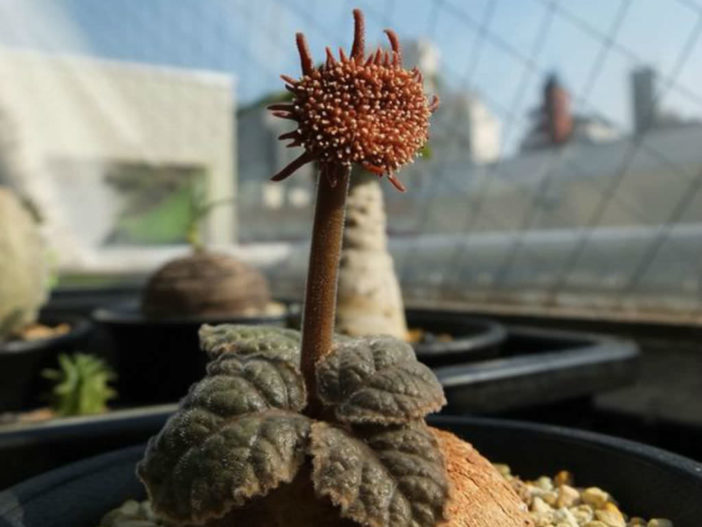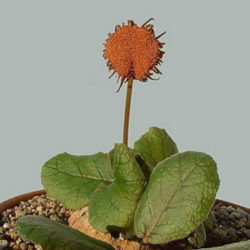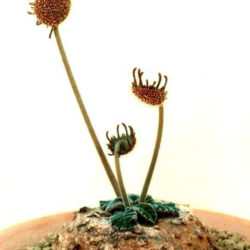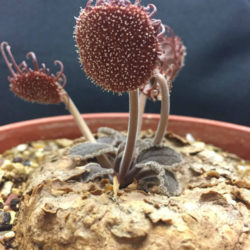Scientific Name
Dorstenia ellenbeckiana Engl.
Scientific Classification
Family: Moraceae
Tribe: Dorstenieae
Genus: Dorstenia
Description
Dorstenia ellenbeckiana is a caudiciform plant with a subglobular tuber and a very short annual stem, sometimes present. The caudex grows up to 2 inches (5 cm) in diameter. Leaves are ovate to elliptic, with 5 to 8 lateral veins and finely toothed margins. They are up to 7.2 inches (18 cm) long, up to 3.8 inches (9.5 cm) wide, and attached to the stem by an up to 3.2 inches (8 cm) long petiole. Both surfaces of the leaves are covered with tiny hairs, especially on the veins and often also near the margins.
This plant is monoecious, having both male and female flowers on the same plant. The flowers are embedded in a disk-shaped, reddish-brown flower structure called receptacles. The receptacles are up to 1 inch (2.5 cm) in diameter, with 8 to 10 long, awl- to band-shaped appendages pointing backward, and appear on up to 5.8 inches (14.5 cm) long stalks.
Origin
Dorstenia ellenbeckiana is native primarily to Somalia, but it is also recorded in Ethiopia and Kenya.
Etymology
The specific epithet "ellenbeckiana (el-len-bek-ee-AY-na)" honors Dr. H. Ellenbeck, a German physician who collected plants during Baron Carlo von Erlanger's expedition to East Africa in 1900-01.

Hardiness
USDA hardiness zones 10b to 11b: from 35 °F (+1.7 °C) to 50 °F (+10 °C).
How to Grow and Care
Dorstenias are warm-loving plants, and they need a bit more water than regular succulents. They need a well-drained potting mix, and their water needs vary depending on the season of the year. Water regularly to abundant from spring to fall. Allow the soil to dry slightly between watering, but make sure that they never dry out completely. During the winter months, these plants tend to go at least partially dormant. During this period, water very little. Giving plants a warm, sunny position can result in beautiful compact growing plants. Fertilizing plants once in a while during their growing period with a high potash and phosphorus fertilizer is recommended.
The spring weather with a high-temperature swing between the day and night hours and pretty frequent rains can favor the development of fungus diseases, which should be treated preemptively with a systemic fungicide.
Dorstenias are generally propagated by seed. Many species are self-fertile. Their seeds are expelled explosively from the mature seed heads and liable to populate pots several feet away. They can also be propagated by cuttings.
Learn more at How to Grow and Care for Dorstenia.
Links
- Back to genus Dorstenia
- Succupedia: Browse succulents by Scientific Name, Common Name, Genus, Family, USDA Hardiness Zone, Origin, or cacti by Genus
Photo Gallery
Click on a photo to see a larger version.


